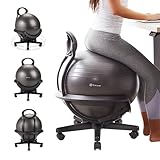10 Best Office Chair For ADHD In 2025
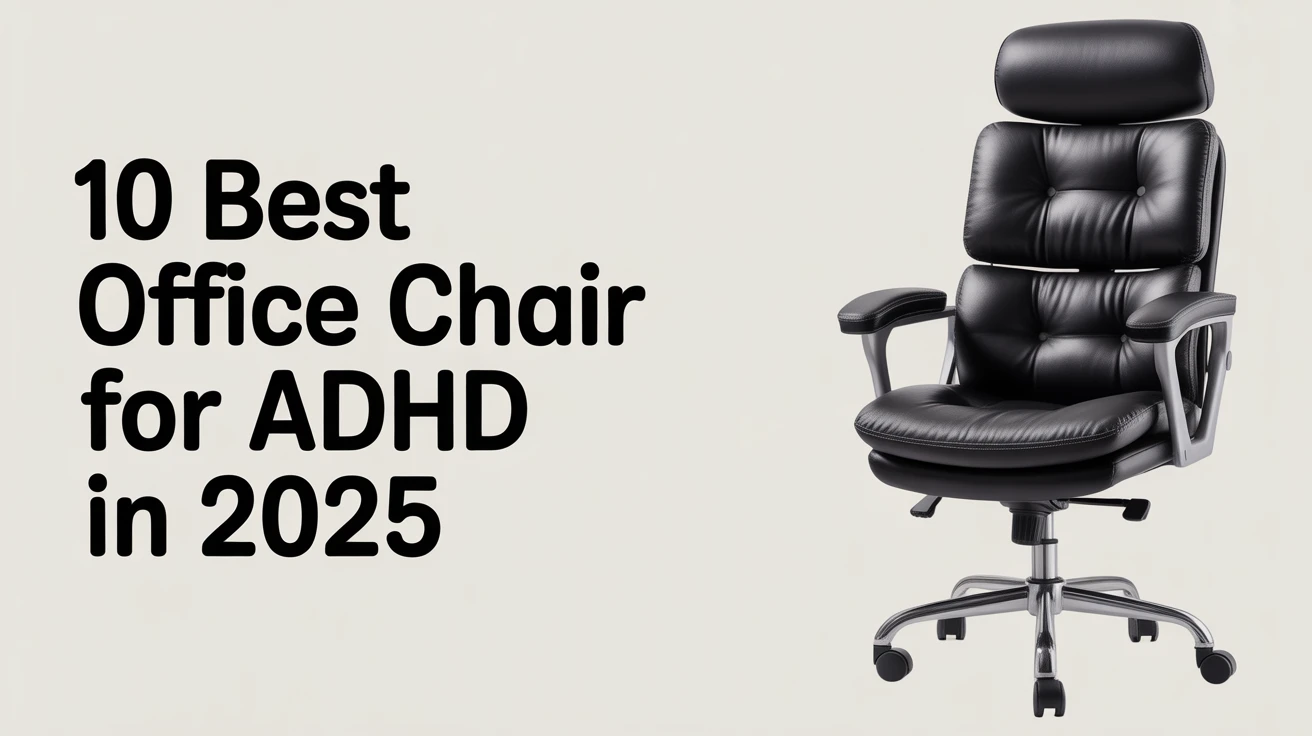
Office chairs for ADHD are designed to encourage dynamic sitting positions, which can help regulate energy levels, reduce discomfort, and enhance focus by providing an outlet for movement. This is particularly beneficial for individuals who struggle with sitting still for extended periods.
This guide will explore the revolutionary seating solutions designed to enhance concentration, reduce restlessness, and boost productivity for individuals with ADHD.
Why Traditional Chairs Fall Short for ADHD?
For individuals with Attention-Deficit/Hyperactivity Disorder (ADHD), traditional office chairs often exacerbate common challenges such as restlessness, difficulty maintaining focus, and discomfort from prolonged static sitting.
The need for movement, diverse sensory input, and the ability to change posture are fundamental to managing ADHD symptoms effectively in a work or study environment.
Specialized chairs in 2025 are designed to address these specific needs, transforming a potentially distracting experience into one that supports concentration and productivity.
The Top 10 Office Chairs for ADHD in 2025
Based on extensive research and user testimonials, the following chairs represent the best options available in 2025 for individuals with ADHD. They are categorized by their primary benefits, although many offer a combination of features.
Chairs Promoting Dynamic Sitting and Movement
These chairs are engineered to keep the body subtly engaged, providing continuous, low-level sensory input that can help channel hyperactivity and improve focus.
HAG Capisco 810

The HAG Capisco 810 stands out with its unique Scandinavian design, encouraging an active sitting posture. Its saddle seat allows for multiple sitting positions—forward, sideways, or even backward—promoting constant movement and adaptability. This chair is particularly beneficial for individuals who struggle to maintain a single posture.
Bloon Posture Ball Chair / Gaiam Classic Balance Ball Chair

These chairs integrate a stability ball into a chair frame, promoting core engagement and subtle, continuous movement. The slight instability requires constant micro-adjustments, which can improve blood flow, boost energy levels, and provide a calming sensory experience for individuals who benefit from fidgeting.
Evo Movement Stool / GoSports Wobble Chair

Wobble stools feature a curved base that enables rocking and swiveling motions. This dynamic seating style actively engages core muscles and encourages spontaneous movement, which can significantly aid focus and reduce restlessness without disrupting workflow.
QOR360 RedRocker

The RedRocker technology in the QOR360 chair facilitates natural rocking and movement, providing an active sitting experience that can enhance concentration and alleviate fidgeting.
Chairs Allowing Multiple Sitting Positions
For many with ADHD, the ability to shift positions, including sitting cross-legged or kneeling, is crucial for comfort and sustained attention. These chairs offer the flexibility needed to accommodate varied postures.
Pipersong Meditation Chair PRO / H-A Meditation Chair

These chairs are designed with wide seats and unique configurations that support multiple non-traditional sitting positions, including cross-legged, squatting, and kneeling. The Pipersong Meditation Chair, in particular, features a 360-degree swivel footstool, providing exceptional freedom of movement and facilitating easy transitions between postures.
A comprehensive review of the Pipersong Meditation Chair, detailing its features and benefits for ADHD users.
Olamide Ergonomic Cross-Legged Swivel Chair / Primy Cross-Legged Office Chair / PINMOCO Fabric Ergonomic Cross-Legged Chair

These chairs provide ample space and support for cross-legged sitting, a preferred posture for many with ADHD. They combine the benefits of ergonomic design with the freedom to adopt alternative, comfortable positions, reducing strain and improving focus.
Ergonomic Kneeling Chairs (e.g., NYPOT Ergonomic Kneeling Chair, R&I Kneeling Chair)

Kneeling chairs promote better posture by distributing weight and encouraging a more open hip angle, which can alleviate back pain and improve alertness. They are excellent for individuals who benefit from varied seating positions and find traditional chairs restrictive.
Traditional Ergonomic Chairs with Enhanced Features
While more traditional in appearance, these chairs incorporate advanced ergonomic features, superior adjustability, and breathable materials that significantly enhance comfort and support, which are vital for individuals with ADHD during long work sessions.
Ergohuman Office Chairs (e.g., Enjoy Elite, Mirus Elite, Ergohuman Elite)

Ergohuman chairs are renowned for their free-float backrests, advanced lumbar support, and highly adjustable armrests. These features allow for dynamic movement, tailored support, and reduce physical strain, making it easier to concentrate. The elastomeric breathable mesh also ensures long-lasting comfort.
NearHub EC20 & EC10 Ergonomic Chairs
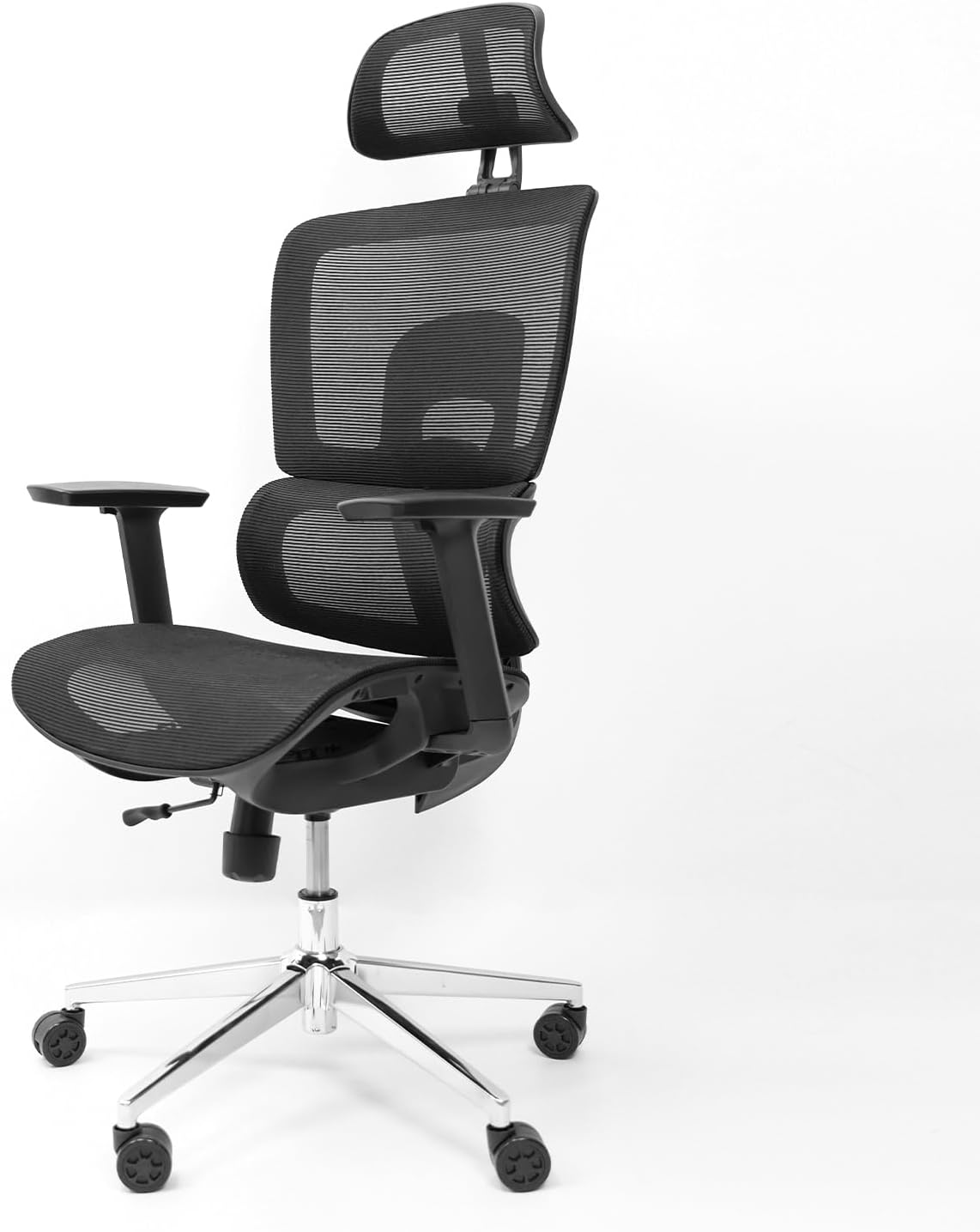
NearHub chairs offer a blend of ergonomic support and spacious design. The EC20 is ideal for taller users, while the EC10 provides compact yet highly adjustable ergonomics for smaller spaces. Both emphasize breathability, good posture promotion, and features that reduce discomfort, directly aiding focus.
Steelcase Series 1 / Steelcase Leap

Steelcase chairs are top-tier ergonomic solutions known for their extensive adjustability, superior comfort, and durability. Features like seat depth adjustment, tilt tension, and adaptive recline mechanisms provide personalized support, making them suitable for prolonged use and highly beneficial for individuals seeking premium ergonomic performance.
Choosing the Right Chair: Factors to Consider
Selecting the best ADHD-friendly chair involves more than just picking a popular model. Individual preferences and needs play a significant role.
Personal Preferences and Sitting Style
Do you prefer sitting cross-legged, kneeling, or do you need to fidget constantly? Chairs vary in their ability to accommodate these styles. For example, individuals who frequently shift positions might benefit most from meditation chairs or wobble stools, while those seeking refined support might lean towards a high-end ergonomic chair.
Ergonomic Adjustability and Support
Key features such as adjustable height, lumbar support, armrests (especially 5D adjustable ones), and seat depth are crucial. These adjustments allow you to tailor the chair to your body, promoting proper posture and reducing physical discomfort that can distract from tasks.
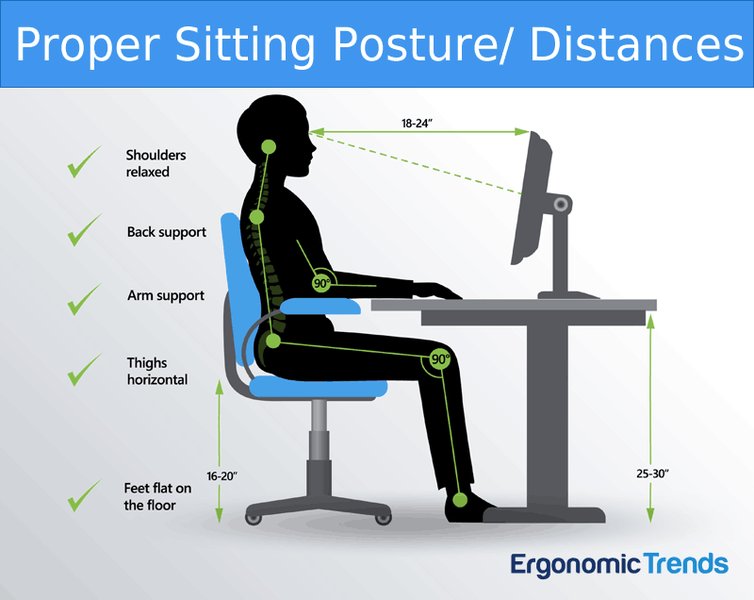
Material and Breathability
Chairs made from breathable mesh or high-quality, padded fabrics can prevent overheating and maintain comfort, especially during long work sessions. This subtle factor contributes significantly to overall focus.
Durability and Investment
While prices vary widely (from $100 to over $500), considering the chair’s durability and the potential long-term benefits to your focus and productivity is important. Many brands offer trial periods, which can be invaluable for testing compatibility.
Feature Prioritization for ADHD Chairs
When making a decision, understanding which features offer the most impact for ADHD can be crucial. This bar chart highlights the perceived importance of various chair features for ADHD users, based on expert consensus and user feedback.
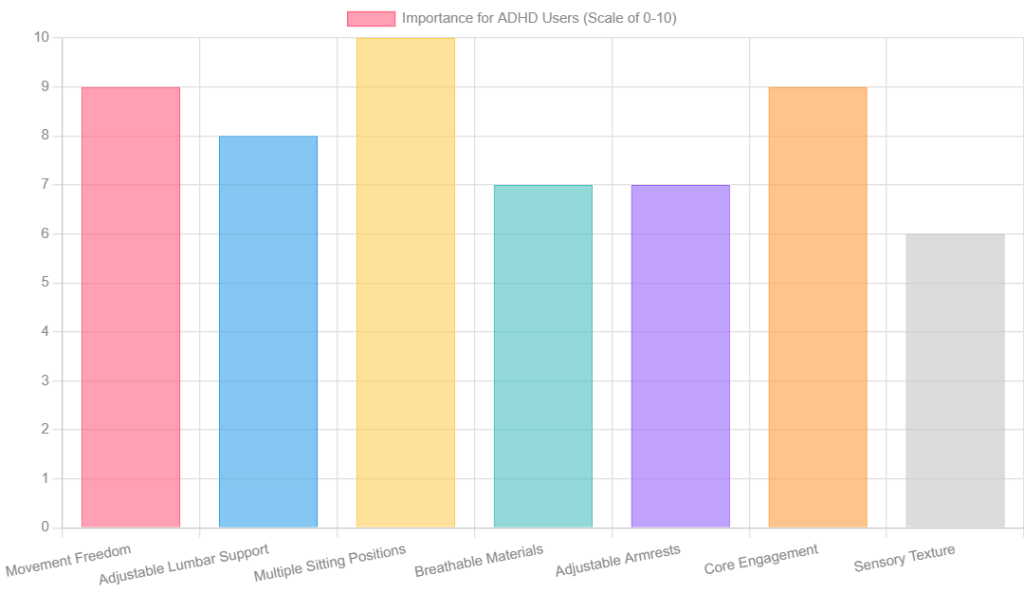
This bar chart visually represents the relative importance of various chair features for individuals with ADHD. “Multiple Sitting Positions” and “Movement Freedom” are ranked highest, underscoring the critical need for dynamic and adaptable seating solutions.
Comparison of Key ADHD-Friendly Chair Types
Here’s a table summarizing the different types of chairs and their primary advantages for ADHD users:
| Chair Type | Primary Benefit for ADHD | Key Features | Example Models |
|---|---|---|---|
| Meditation Chairs | Allows diverse sitting postures (cross-legged, kneeling, squatting) | Wide seat, 360° swivel, crescent backrest, memory foam | Pipersong Meditation Chair PRO, H-A Meditation Chair |
| Active Sitting Chairs | Encourages continuous subtle movement and core engagement | Wobble base, balance ball integration, dynamic rocking | Bloon Posture Ball Chair, Evo Movement Stool, Gaiam Classic Balance Ball Chair |
| Ergonomic Kneeling Chairs | Promotes upright posture, reduces slouching, distributes weight | Knee pads, adjustable height, back support | NYPOT Ergonomic Kneeling Chair, R&I Kneeling Chair |
| Advanced Ergonomic Office Chairs | Comprehensive adjustability, superior support, dynamic movement in traditional form | 5D armrests, free-float backrest, lumbar support, breathable mesh | Ergohuman Elite, Steelcase Series 1, NearHub EC20 |
This table provides a concise overview of the various types of ADHD-friendly chairs, highlighting their unique benefits and features.
FAQ: Finding Your Ideal ADHD Chair
What is the most crucial feature for an ADHD office chair?
The most crucial feature is the chair’s ability to facilitate movement and accommodate multiple sitting positions. This allows individuals to fidget or shift their posture, which is essential for managing restlessness and maintaining focus.
Are balance ball chairs good for ADHD?
Yes, balance ball chairs can be very beneficial for individuals with ADHD as they encourage subtle, continuous movement and core engagement. This dynamic sitting provides sensory input that can help channel hyperactivity and improve concentration.
Can ergonomic chairs truly help with ADHD focus?
While ergonomic chairs don’t directly treat ADHD, their advanced adjustability and support significantly reduce physical discomfort and promote proper posture. By alleviating distractions caused by pain or poor positioning, they create an environment more conducive to sustained focus.
What is a “cross-legged” office chair?
A cross-legged office chair is designed with an extra-wide seat or specific configuration that comfortably allows users to sit in non-traditional positions, such as cross-legged or kneeling, while still at a desk. These chairs cater to those who prefer these postures for comfort and focus.
Should I consider a standing desk alongside an ADHD-friendly chair?
Yes, combining an ADHD-friendly chair with a standing desk is highly recommended. It offers the flexibility to alternate between sitting and standing, providing even more opportunities for movement and reducing the static nature of traditional workstations, which can greatly benefit individuals with ADHD.
Conclusion: Empowering Focus Through Intelligent Seating
In 2025, the landscape of office chairs for individuals with ADHD is rich with innovative solutions designed to meet diverse needs. From dynamic active-sitting options and versatile meditation chairs to highly adjustable ergonomic models, the core principle remains consistent: providing seating that supports movement, encourages varied postures, and optimizes comfort.
By prioritizing these features, individuals with ADHD can transform their workspaces into environments that foster greater focus, reduce restlessness, and ultimately enhance productivity.
The right chair isn’t just a piece of furniture; it’s a tool for empowerment, helping to unlock concentration and achieve sustained engagement in tasks.


